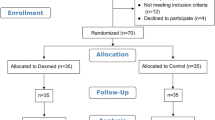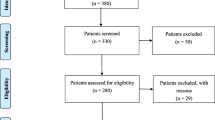Abstract
Background and objectives
Laryngoscopy and tracheal intubation are associated with hemodynamic responses that might increase morbidity and mortality in some patients. Lornoxicam is a nonsteroidal anti-inflammatory drug, which, when added to fentanyl, successfully attenuated the pressor response of intubation. The aim of this study was to evaluate the effect of lornoxicam on the hemodynamic response and serum catecholamine levels following laryngoscopy and tracheal intubation.
Methods
Fifty adult patients scheduled for general anaesthesia with endotracheal intubation were enrolled in this randomized, double-blind placebo-controlled study. They were divided into two equal groups to receive intravenously either lornoxicam 16 mg or placebo 30 min before surgery. Mean arterial pressure and heart rate were recorded before and after induction of anaesthesia, and every minute after intubation for 10 min. Serum catecholamine levels were measured before induction and 1 min after intubation.
Results
After induction, there was a significant decrease in blood pressure in both groups. In the first 3 min after tracheal intubation, a significant increase in the hemodynamic parameters and in the serum norepinephrine level was observed in the control group.
Conclusion
Lornoxicam 16 mg attenuates the pressor response to laryngoscopy and intubation of the trachea.
Similar content being viewed by others
References
Reid LC, Brace DE (1940) Irritation of the respiratory tract and its reflex effect upon heart. Surg Gynaec Obstet 70:157–162
Russell WJ, MorrIs RG, Frewin DB, Drew SE (1981) Changes in plasma catecholamine concentration during endotracheal intubation. Br J Anaesth 53:837–839
Kovac AL (1996) Controlling the hemodynamic response to laryngoscopy and endotracheal intubation. J Clin Anesth 8:63–79
Fassoulaki A, Kaniaris P (1983) Intranasal administration of nitroglycerin attenuates the pressor response to laryngoscopy and intubation of the trachea. Br J Anaesth 55:49–52
Vucevic M, Purdy GM, Ellis FR (1992) Esmolol hydrochloride for management of the cardiovascular stress responses to laryngoscopy and tracheal intubation. Br J Anaesth 68:529–530
Malde AD, Sarode V (2007) Attenuation of the hemodynamic response to endotracheal intubation: fentanyl versus lignocaine. Internet J Anesthesiol 12 (1)
McCormack K (1999) The evolving NSAID: focus on lornoxicam. Pain Rev 6(4):262–278
Riad W, Moussa A (2008) Lornoxicam attenuates the hemodynamic responses to laryngoscopy and tracheal intubation in the elderly. Eur J Anaesthesiol 25:732–736
Ankier SI, Brimelow AE, Crome P, Johnston A, Warrington SJ, Turner P, Ferber HP (1988) Chlortenoxicam pharmacokinetics in young and elderly human volunteers. Postgrad Med J 64:752–754
Holly JMP, Makin HLJ (1983) The estimation of catecholamines in human plasma: a review. Anal Biochem 128:257–274
Zhao H, Ye TH, Gong ZY, Xue Y, Xue ZG, Huang WQ (2005) Application of lornoxicam to patient-controlled analgesia in patients undergoing abdominal surgeries. Chin Med Sci J 20:59–62
Norholt ES, Pedersen S, Larsen U (1996) Pain control after dental surgery: a double blind, randomized trial of lornoxicam versus morphine. Pain 67:335–343
Balanika M, Tsitsika M, Wilczynski W (2000) The use of lornoxicam-mepridine combination for postoperative analgesia. Eur J Anaesthiol 17:771–778
Staunstrup H, Ovesen J, Larsen T (1999) Efficacy and tolerability of lornoxicam versus tramadol in postoperative pain. J Clin Pharmacol 39:834–841
Daabiss M, Al-Sherbiny M, Al-Otaibi R, El-Nimar R (2009) Analgesia in day-case ENT surgery: the efficacy of lornoxicam. Br J Med Pract 2(3):46–50
Hitzenberger G, Radhofer-Welte S, Takacs F, Rosenow D (1990) Pharmacokinetics of lornoxicam in man. Postgrad Med J 66(Suppl 4):S22–S27
Buritova J, Besson JM (1998) Dose-related anti-inflammatory analgesic effects of lornoxicam: a spinal c-Fos protein study in the rat. Inflamm Res 47(1):18–25
Bruder N, Granthil C, Ortega D (1992) Consequences and prevention methods of hemodynamic changes during laryngoscopy and intubation. Ann Fr Anaesth Reanim 11(1):57–71
Kihara S, Brimacombe J, Yaguchi Y, Watanabe S, Taguchi N, Komatsuzaki T (2003) Hemodynamic responses among three tracheal intubation devices in normotensive and hypertensive patients. Anesth Analg 96:890–895
Shribman AJ, Smith G, Achola kJ (1987) Cardiovascular and catecholamine response to laryngoscopy with and without endotracheal intubation. Br J Anaesth 59:295–299
Hassan HG, El-Sharkawy, Renk H, Mansour G, Fouda A (1991) Haemodynamic and catecholamine responses to laryngoscopy with vs, without endotracheal intubation. Acta Anaesthesiol Scand 35:442
Financial support
None.
Conflict of interest
None.
Author information
Authors and Affiliations
Corresponding author
Rights and permissions
About this article
Cite this article
Daabiss, M., Hashish, M. Effects of lornoxicam on the hemodynamic and catecholamine response to laryngoscopy and tracheal intubation. Eur J Clin Pharmacol 67, 783–786 (2011). https://doi.org/10.1007/s00228-011-1017-4
Received:
Accepted:
Published:
Issue Date:
DOI: https://doi.org/10.1007/s00228-011-1017-4




